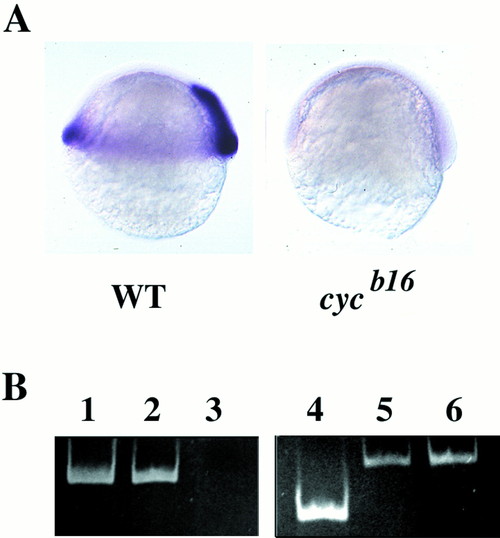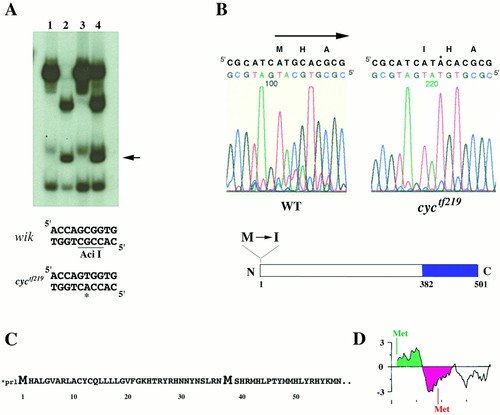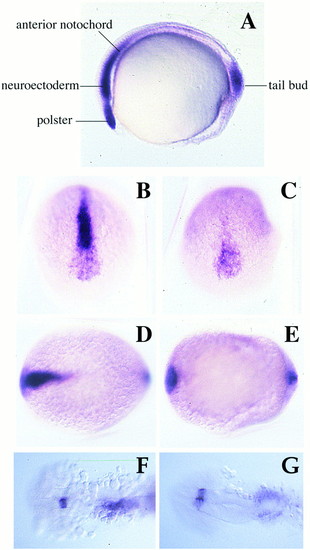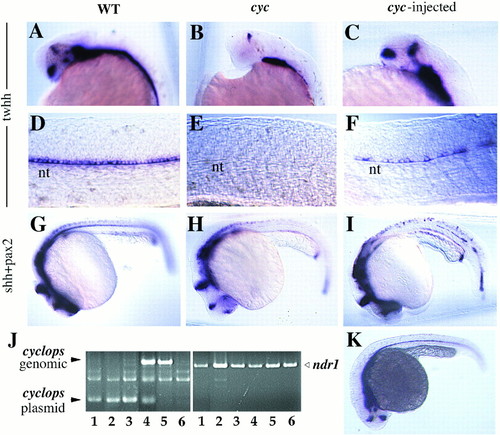- Title
-
cyclops encodes a nodal-related factor involved in midline signaling
- Authors
- Rebagliati, M.R., Toyama, R., Haffter, P., Dawid, I.B.
- Source
- Full text @ Proc. Natl. Acad. Sci. USA
|
(A) ndr2 RNA is present in wild-type (WT) but not homozygous cycb16 embryos, as seen by in situ hybridization at the shield stage (28). (B) ndr2 is deleted in cycb16 DNA, visualized by PCR. Lanes: 1, ndr2 primer pair 1 + ndr2 plasmid; 2, ndr2 primer pair 1 + wild-type genomic DNA; 3, ndr2 primer pair 1 + cycb16 homozygous genomic DNA; 4, ndr2 primer pair 2 + ndr2 plasmid; 5, ndr1 primers + ndr2 primer pair 2 + cycb16 genomic DNA; 6, ndr1 primers + ndr1 plasmid. |
|
(A) ndr2 is linked to cyctf219, as shown by segregation of an Aci I restriction polymorphism in ndr2 sequences (16) amplified from genomic DNAs of a mapping cross. Lanes: 1, heterozygous cyctf219 G0 fish; 2, homozygous wild-type G0 fish (WIK strain); 3, F2 mutant sibs (homozygous cyctf219); 4, F2 phenotypically wild-type (heterozygous and homozygous wild-type) sibs. Arrow denotes fragment generated by Aci I site present in the WIK but not the cyctf219 strain; this restriction fragment length polymorphism segregates with the cyc mutation, demonstrating linkage. (B) The first methionine of the ndr2 ORF is changed to isoleucine in cyctf219; the M→I mutation was verified in two independent amplification products. In the schematic drawing, shading denotes region of mature Ndr2 polypeptide (382-501). (C) Translation of ndr2 sequence showing the first 61 aa of the ORF (upper case). Asterisk denotes the first in-frame stop codon upstream of the initiating methionine. (D) Hydrophobicity plot of the N-terminal region of Ndr2, generated with the PEPPLOT program of the GCG package; green and red denote hydrophobic and hydrophilic regions, respectively. |
|
(A) The Ndr2 protein encoded by the cyctf219 allele lacks a functional signal sequence, as judged by the failure to be glycosylated. Proteins from coupled transcription-translation reactions with expression plasmids that initiate at the wild-type met (WT) or the second met at position 38 (corresponding to cyctf219, denoted M) were analyzed under denaturing and reducing conditions. Aliquots were treated with or without dog pancreatic microsomes (Mic.) and±endoglycosidase H. The arrow indicates the glycosylated form of the polypeptide. (B) Northern blot analysis of the in vivo activity of wild-type (WT) and mutant (M) RNA in the Xenopus animal cap assay, using nrp-1 as a probe for neural induction (28). U, uninjected; pg, amount of RNA injected per embryo; 18S rRNA was used as a loading control; 7x, sevenfold longer exposure of the two lanes at the right to illustrate the inactivity of the mutant RNA. |
|
The expression pattern of cyc at the bud stage is modified in cyctf219 mutant embryos. (A) The wild-type pattern (28). Cyc RNA is seen in the tailbud, and the anterior notochord and prechordal plate including the polster (hatching gland precursor). (B, C, and F) Wild-type sibs. (D, E, and G) cyctf219 mutant embryos. Anterior views (B and D) and dorsal views (C-G) are shown. At the tailbud stage, expression in tailbud and polster is essentially unaffected in cyctf219, but expression in the prechordal plate, ventral neuroectoderm, and anterior notochord is largely lost. At the 20-somite stage, asymmetry of staining in the lateral plate and diencephalon is lost in mutant embryos. |
|
Rescue of the cycb16 phenotype by injection of a cyc expression construct. Wild-type (A, D, and G), cyc (B, E, and H), and cyc rescued by injection of 0.5 pg DNA per embryo (C, F, I, and K) are shown, as hybridized with twhh (A-F and K) or shh and pax2 (G-I). (J) After staining, the embryos were genotyped by PCR with primers that span an intron in the cyc gene; injected embryos also showed amplification product from the intronless expression plasmid. Aliquots of the same DNA samples also were amplified with primers for the unlinked ndr1 gene as a positive control. Lanes: 1, amplification of DNA from embryo in C; 2, F; 3, I; 4, injected wild type; 5, uninjected wild type; 6, uninjected cyc. |





